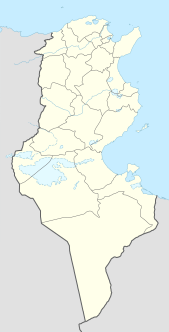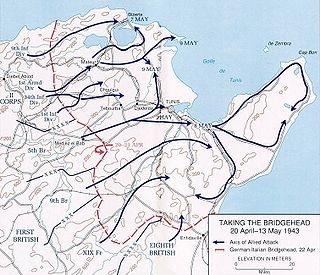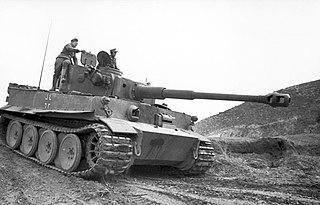 W
WThe Tunisian campaign was a series of battles that took place in Tunisia during the North African campaign of the Second World War, between Axis and Allied forces. The Allies consisted of British Imperial Forces, including a Greek contingent, with American and French corps. The battle opened with initial success by the German and Italian forces but the massive supply interdiction efforts led to the decisive defeat of the Axis. Over 250,000 German and Italian troops were taken as prisoners of war, including most of the Afrika Korps.
 W
WThe 6th Armoured Division was an armoured division of the British Army, created in September 1940 during the Second World War. In October 1940, armoured regiments within the Division, such as the 2nd Lothian and Border Horse, were supplied with Matilda MkI.I tanks, then in May 1942 Crusader MkII tanks, in August 1942 Valentine Mk.V tanks and finally in October Crusader MKIIIs. In North Africa tankers were finally put on an almost equal footing to their Panzer counterparts when the M4A2 Sherman medium tank was added to their inventory by March 1943. In November/December 1942 The division participated in the Operation Torch assault landings in Bone, closest to the Axis Forces in all the Torch landings that stretched from Morocco to the Tunisian border. In November 1942 they saw their first action as part of V Corps of the British First Army, First Allied Army in the Tunisia Campaign. In March 1943, around the same time when most of the units had been supplied with American M4A2 Shermans, the Sixth Division came under IX Corp. After Tunisia, the Division participated in the Italian Campaign as part of the British Eighth Army and ended the war in Austria, again under the command of V Corps.
 W
WThe 2nd Battle of Longstop Hill or the Capture of Longstop Hill took place in Tunisia during the Tunisia Campaign of World War II from 21 to 23 April 1943. The battle was fought for control over the heights of Djebel el Ahmera and Djebel Rhar, together known as Longstop Hill and vicinity, between the British forces of the First Army and German units of the 5th Panzer Army. The infantry of the 78th Battleaxe Division and Churchill tanks of the North Irish Horse captured Longstop Hill after bitter fighting, in which the tanks created a measure of tactical surprise by driving up the hill, a manoeuvre that only Churchill tanks could achieve. The attackers broke through the German defences, which were the last great natural barrier on the road to Tunis.
 W
WSedjenane is a town in northern Tunisia, on the railway line to Mateur and the port of Bizerta. The Battle of Sedjenane was fought during World War II between the Allies and Axis for control of a town in northern Tunisia, on the railway line to Mateur and the port of Bizerta. The battle was part of the Tunisia Campaign.
 W
WThe Battle of El Guettar was a battle that took place during the Tunisia Campaign of World War II, fought between elements of the Army Group Africa under General Hans-Jürgen von Arnim, along with Italian First Army under General Giovanni Messe, and U.S. II Corps under Lieutenant General George Patton in south-central Tunisia. It was the first battle in which U.S. forces were able to defeat the experienced German tank units, but the followup to the battle was inconclusive.
 W
WThe Battle of Hill 609 took place at Djebel Tahent in northwestern Tunisia during the Tunisia Campaign. The battle was for control over the key strategic height Hill 609 and its surrounding area between the American forces of the U.S. II Corps and German units of the Afrika Korps. The battle proved a formative experience for the American forces - in their first clear-cut victory of the campaign, and has been called "the American Army's coming-of-age."
 W
WThe Battle of Kasserine Pass was a series of battles of the Tunisia Campaign of World War II that took place in February 1943 at Kasserine Pass, a 2-mile-wide (3.2 km) gap in the Grand Dorsal chain of the Atlas Mountains in west central Tunisia.
 W
WThe Mareth Line was a system of fortifications built by France in southern Tunisia in the late 1930s. The line was intended to protect Tunisia against an Italian invasion from its colony in Libya. The line occupied a point where the routes into Tunisia from the south converged, leading toward Mareth, with the Mediterranean Sea to the east and mountains and a sand sea to the west.
 W
WThe Battle of the Mareth Line or the Battle of Mareth was an attack in the Second World War by the British Eighth Army in Tunisia, against the Mareth Line held by the Italo-German 1st Army. It was the first big operation by the Eighth Army since the Second Battle of El Alamein 4+1⁄2 months previously. On 19 March 1943, Operation Pugilist, the first British attack, established a bridgehead but a break-out attempt was defeated by Axis counter-attacks. Pugilist established an alternative route of attack and Operation Supercharge II, an outflanking manoeuvre via the Tebaga Gap was planned. Montgomery reinforced the flanking attack, which from 26 to 31 March, forced the 1st Army to retreat to Wadi Akarit, another 40 mi (64 km) back in Tunisia.
 W
WThe Battle of Medenine was an Axis spoiling attack at Medenine in Tunisia on 6 March 1943. The operation was intended to delay an attack by the British Eighth Army on the Mareth Line. The British had been forewarned by Ultra decrypts of German wireless communications and rushed reinforcements from Tripoli and Benghazi before the Axis attack, which was a costly failure. General Erwin Rommel, the commander of Army Group Africa (Heeresgruppe Afrika), could not afford to lose forces needed for the defence of the Mareth Line and the effort was abandoned at dusk that day.
 W
WThe North African campaign of the Second World War took place in North Africa from 10 June 1940 to 13 May 1943. It included campaigns fought in the Libyan and Egyptian deserts and in Morocco and Algeria, as well as Tunisia.
 W
WUnternehmen Ochsenkopf also known as the Battle of Sidi Nsir and the Battle of Hunts Gap was an Axis offensive operation in Tunisia from 26 February to 4 March 1943, during the Tunisia Campaign of the Second World War. The offensive and a subsidiary operation Unternehmen Ausladung, was intended to gain control of Medjez el Bab, Béja, El Aroussa, Djebel Abiod and a position known as Hunt's Gap, between the British First Army and the Axis Army Group Africa. The offensive gained some ground, but none of the more ambitious objectives were achieved before the operation was called off, due to increasing losses of infantry and tanks, particularly the heavy Tigers. Unternehmen Ochsenkopf was the last big Axis offensive by the 5th Panzer Army before the final Allied offensive in April and May in which the Allies occupied Tunisia and took the surviving 250,000 Axis troops into captivity.
 W
WOperation Flax was a Western Allied air operation executed during the Tunisian campaign, as part of the larger North African campaign of the Second World War. The operation was designed to cut the air supply lines between Italy and the Axis armies in Tunis, Tunisia, in April 1943. The parallel Allied naval effort was Operation Retribution.
 W
WOperation Retribution was the Second World War air and naval blockade designed to prevent the seaborne evacuation of Axis forces from Tunisia to Sicily. Axis forces were isolated in northern Tunisia and faced a final Allied assault. The equivalent blockade of air evacuation was Operation Flax.
 W
WOperation Vulcan and Operation Strike were the final ground attacks by the Allied forces against the Italian and German forces in Tunis, Cape Bon, and Bizerte, the last Axis toeholds in North Africa, during the Tunisia Campaign of the Second World War.
 W
WThe Run for Tunis was part of the Tunisia Campaign which took place during November and December 1942 during the Second World War. Once French opposition to the Allied Operation Torch landings had ceased in mid-November, the Allies made a rapid advance by a division-sized force east from Algeria, to capture Tunis and forestall an Axis build up in Tunisia and narrowly failed. Some Allied troops were fewer than 20 miles (32 km) short of Tunis by late November but the defenders counter-attacked and pushed them back nearly 20 miles (32 km), to positions which had stabilised by the end of the year.
 W
WThe Battle of Sidi Bou Zid (Unternehmen Frühlingswind/Operation Spring Breeze) took place during the Tunisia Campaign from 14–17 February 1943, in World War II. The battle was fought around Sidi Bou Zid, where a large number of US Army units were mauled by German and Italian forces. It resulted in the Axis forces recapturing the strategically important town of Sbeitla in central Tunisia.
 W
WTiger 131 is a German Tiger I heavy tank captured by the British 48th Royal Tank Regiment in Tunisia during World War II. Preserved at The Tank Museum in Bovington in Dorset, England, it is the only operating Tiger I in the world as of early 2021.
 W
WThe Battle of Wadi Akarit was an Allied attack from 6 to 7 April 1943, to dislodge Axis forces from positions along the Wadi Akarit in Tunisia during the Tunisia Campaign of the Second World War. The Gabès Gap, north of the towns of Gabès and El Hamma, is a passage between the sea and impassable salt marshes. The 51st (Highland) Infantry Division breached the defences and held a bridgehead, allowing the passage of their main force to roll up the Axis defences. After several determined counter-attacks, the Axis forces withdrew and the Eighth Army, under General Bernard Montgomery, pursued toward Tunis, until reaching Axis defensive positions at Enfidaville.